6 Stretches You Can Do To Offset It
For most of us, sitting at a desk for seven or eight hours a day is a daily necessity. Coupled with the one to two hours that we also tend to spend traveling to and from that desk, not to mention the couch time we log once we’re home, our lives have become undeniably (and increasingly) sedentary.
While sitting is certainly more comfortable than standing for extended periods of time, it poses many risks to our health. Dr. James A. Levine of the Mayo Clinic identified some of those downsides in an expert answers segment, listing a nearly 50% increased risk of death from any cause as easily the most staggering warning.
The best and most compact resource I’ve come across to explain the risks of prolonged and regular sitting is the animated video “Why Sitting is Bad For You.” Based on the Ted Ed talk of Murat Dalkilinç, a physiotherapist with extensive experience in sports injuries and persistent pain, this five minute video paints a frightening picture of our daily lives.
While sitting may be difficult, if not impossible, to avoid, there are things we can do to mitigate its harms. Here are 6 stretches we can all begin to incorporate today to help protect against the effects of prolonged sitting:
1. Glute Bridge
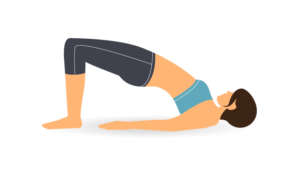 HOW TO: Lie on your back with your knees bent to approximately 45 degrees and your feet hip distance apart. Your lower back should be flat on the floor. Drive through your heels as you contract your glutes and push your hips off the ground, making sure not to arch your lower back, then lower your hips back to the ground.
HOW TO: Lie on your back with your knees bent to approximately 45 degrees and your feet hip distance apart. Your lower back should be flat on the floor. Drive through your heels as you contract your glutes and push your hips off the ground, making sure not to arch your lower back, then lower your hips back to the ground.BENEFIT: Glute bridges, along with many other lower-body exercises, are great for hip extension — the opposite of what we do while sitting. By extending our hips as much as possible in a safe exercise, we counteract the negative effects of sitting by stretching out and moving our muscles in the opposite direction.
2. Squats
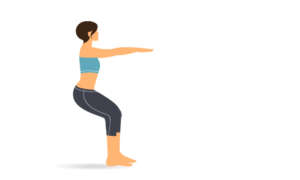
HOW TO: Stand with your feet hip distance apart. Engage your core as you push your hips back and down as if preparing to sit down. Drive everything through your heels as you come down and return to a standing position, ensuring that your knees do not push forward past your toes when coming down and that your back stays flat throughout.
BENEFIT: Squats offer similar benefits to the glute bridge, but engage the muscles differently. Combined, they provide a comprehensive stretch/exercise.
3. Shoulder Opener
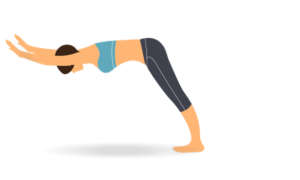 HOW TO: Place a backwards facing chair approximately three feet in front of you (adjusting as necessary depending on your height). Stand with your feet hip distance apart. Lift your arms toward the sky, then slowly bend forward at your waist, grabbing the back of the chair with your outstretched arms.
HOW TO: Place a backwards facing chair approximately three feet in front of you (adjusting as necessary depending on your height). Stand with your feet hip distance apart. Lift your arms toward the sky, then slowly bend forward at your waist, grabbing the back of the chair with your outstretched arms.BENEFIT: Most of us sit at least slightly hunched over. Shoulder openers counteract this hunched position and open up the shoulders.
4. Cobra
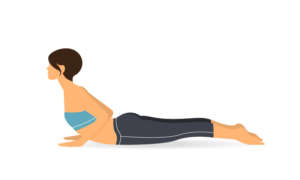 HOW TO: Lay on your stomach with your arms beside you, then bring your hands in line with your chest. With your hands pressed firmly against the ground, slowly bring your upper body off the floor while pressing your lower body into the ground through to the tips of your toes. Extend and hold for a few breaths before slowly lowering back down.
HOW TO: Lay on your stomach with your arms beside you, then bring your hands in line with your chest. With your hands pressed firmly against the ground, slowly bring your upper body off the floor while pressing your lower body into the ground through to the tips of your toes. Extend and hold for a few breaths before slowly lowering back down.BENEFIT: Cobra pose is a remarkable yoga stretch that strengthens your back while simultaneously stretching your chest and hip flexors. When done correctly, it essentially moves your muscles in the opposite direction of a sitting position.
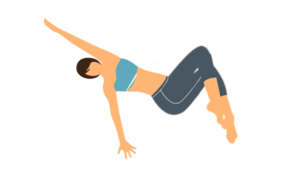
HOW TO: Lie flat on your back with your arms and legs apart in a relaxed state. Slowly bring your knees to your chest. Let them both slowly fall to one side while your torso stays neutral. Hold for a few cycles of breath and then move to the other side.
BENEFIT: This move fully stretches out your lower back, which is often the most negatively affected by prolonged sitting.
6. Pigeon Stretch
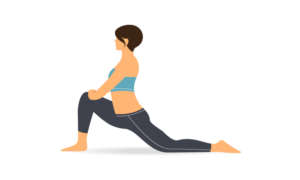 HOW TO: Starting in downward facing dog, bend one knee and place it on your mat slightly wider than your hip. Fold forward over your parallel shin while keeping the other leg extended behind you.
HOW TO: Starting in downward facing dog, bend one knee and place it on your mat slightly wider than your hip. Fold forward over your parallel shin while keeping the other leg extended behind you.BENEFIT: Pigeon’s greatest benefit comes in its impact to your sitting posture moving forward. It strengthens and stretches your muscles in a way that should make sitting in a neutral position more natural than a compromised one.
The Best Possible Solution
In my (admittedly unprofessional) opinion, the best way to stay healthy is to be proactive rather than reactive. Instead of letting your ailments mount until they can no longer be ignored, take the time to do things now that prevent them from ever getting to that point.
In addition to incorporating these stretches, find ways to break up the time you must spend sitting at work. Use a standing desk if one is available to you, go for a walk during lunch, and take short breaks throughout the day to stand up and stretch things out.
Incorporating yoga into your weekly life is another fantastic preventative measure that not only builds strength and flexibility, but prevents future injury. If you aren’t comfortable going to classes in your neighbourhood, try doing it at home. My personal favourite in-home video instructor is Rodney Yee. Through GAIAM, Rodney has created a number of easy-to-follow videos for people of all levels.
Sources:
http://spotmebro.com/8-stretches-sit-much/2/
http://www.livestrong.com/slideshow/1011457-15minute-workout-save-desk/#slide=1
“Stuck Sitting All Day? 6 Stretches You Can Do To Offset It” by Mark DeNicola was originally published on Collective Evolution.



